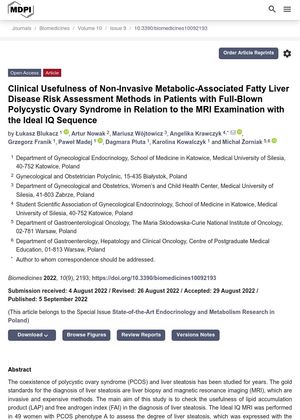TLDR Lipid Accumulation Product and Free Androgens Index are effective for assessing fatty liver disease risk in women with Polycystic Ovary Syndrome.
The study conducted on 49 women with Polycystic Ovary Syndrome (PCOS) found that Lipid Accumulation Product (LAP) and Free Androgens Index (FAI) are effective non-invasive methods for assessing the risk of Metabolic-Associated Fatty Liver Disease (MAFLD). A LAP value over 70.25 and a FAI value over 5.05 were associated with liver steatosis, with women having LAP > 70.25 and FAI > 5.05 at 4.07 to 80.38 and 3.04 to 45.27 times higher risk of liver steatosis respectively. However, Sex Hormone-Binding Globulin (SHBG), a component of FAI, was not a significant predictor of liver steatosis. These findings suggest that LAP and FAI can be used to diagnose liver steatosis in women with PCOS, where MAFLD prevalence is around 30-70%.
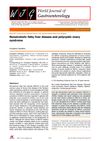 114 citations
,
January 2014 in “World Journal of Gastroenterology”
114 citations
,
January 2014 in “World Journal of Gastroenterology” People with PCOS, especially if obese, often have NAFLD, linked to obesity, insulin resistance, and high androgen levels.
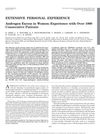 947 citations
,
February 2004 in “The Journal of Clinical Endocrinology and Metabolism”
947 citations
,
February 2004 in “The Journal of Clinical Endocrinology and Metabolism” Most women with excess male hormones have Polycystic Ovary Syndrome, and hormonal therapy can improve symptoms but may cause side effects.
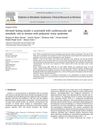 17 citations
,
May 2019 in “Diabetes and Metabolic Syndrome: Clinical Research and Reviews”
17 citations
,
May 2019 in “Diabetes and Metabolic Syndrome: Clinical Research and Reviews” High fasting insulin levels in women with PCOS are linked to a higher risk of heart and metabolic problems.
 December 2015 in “University of Birmingham Institutional Research Archive (University of Birmingham)”
December 2015 in “University of Birmingham Institutional Research Archive (University of Birmingham)” AKR1C3 could be a treatment target for metabolic issues in PCOS.
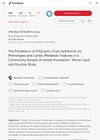 9 citations
,
March 2022 in “Frontiers in Endocrinology”
9 citations
,
March 2022 in “Frontiers in Endocrinology” About 19.4% of Iranian women in the study have Polycystic Ovary Syndrome, with the most common type involving irregular periods and high male hormone levels, but their heart and metabolic health is similar to women without the condition.
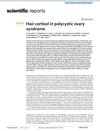 2 citations
,
June 2022 in “Scientific reports”
2 citations
,
June 2022 in “Scientific reports” Women with PCOS have higher hair cortisol levels, which are linked to worse metabolic and inflammatory conditions.
317 citations
,
April 2018 in “Journal of steroid biochemistry and molecular biology/The Journal of steroid biochemistry and molecular biology” PCOS is a complex condition in women that can lead to health issues, and lifestyle changes are the best management approach.
